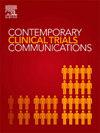Response variability to exercise (REVISE): Study rationale, design and methods
IF 1.4
Q4 MEDICINE, RESEARCH & EXPERIMENTAL
引用次数: 0
Abstract
Physical inactivity and low levels of cardiorespiratory fitness (CRF, VO2peak) are major threats to public health. In response, leading health authorities worldwide recommend that all adults accumulate 150 min/wk of moderate to-vigorous physical activity. However, we and others have demonstrated an extraordinary inter-individual variability in CRF response to standardized exercise wherein a substantial number of adults may not improve CRF beyond day-to-day variability. Whether CRF response to first line therapy is a permanent feature of the individual or can be altered by increasing exercise dose is unknown. We will perform a single-centre, two-phased, randomized controlled trial. In Phase I we will randomly assign previously inactive, adult men and women between 25 and 65 years in a 1:9 ratio to a no-exercise wait-list control, or a low amount, low intensity (∼150 min/wk) group for 16 weeks. In Phase II (16 weeks), participants randomized to exercise in phase I will be re-randomized to 1 of 3 exercise groups: 1) the same low amount, low intensity; 2) low amount, high intensity, or 3) high amount, high intensity. The primary outcome is CRF. Our primary question is, after 16 weeks of ∼150 min/wk of moderate intensity exercise, does increasing exercise intensity or exercise amount for an additional 16 weeks improve CRF differently depending on the response to exercise during the first 16 weeks? The findings will provide first evidence and immense opportunity for development of a more personalized approach to exercise that recognizes individual response variability.
Trial registration
clinicaltrials. gov identifier: NCT05496751.
对运动的反应变异性(修订):研究的基本原理、设计和方法
缺乏身体活动和低水平的心肺功能(CRF, vo2峰值)是对公众健康的主要威胁。为此,世界主要卫生当局建议所有成年人每周积累150分钟的中等至高强度身体活动。然而,我们和其他人已经证明了标准化运动对CRF反应的不同个体间差异,其中相当多的成年人可能无法改善CRF,超出日常变化。CRF对一线治疗的反应是否是个体的永久性特征,还是可以通过增加运动剂量来改变尚不清楚。我们将进行一项单中心、两阶段、随机对照试验。在第一阶段,我们将25 - 65岁的成年男性和女性按1:9的比例随机分配到无运动候补组,或低量、低强度(约150分钟/周)组,为期16周。在第二阶段(16周),被随机分配到第一阶段运动的参与者将被重新随机分配到三个运动组中的一个:1)相同的低量、低强度;2)数量少,强度高,或3)数量多,强度高。主要结果是CRF。我们的主要问题是,在进行16周~ 150分钟/周的中等强度运动后,在另外16周增加运动强度或运动量是否会根据前16周对运动的反应而不同地改善CRF ?这些发现将提供第一个证据和巨大的机会,以发展一种更加个性化的锻炼方法,识别个体反应的可变性。registrationclinicaltrials审判。gov标识符:NCT05496751。
本文章由计算机程序翻译,如有差异,请以英文原文为准。
求助全文
约1分钟内获得全文
求助全文
来源期刊

Contemporary Clinical Trials Communications
Pharmacology, Toxicology and Pharmaceutics-Pharmacology
CiteScore
2.70
自引率
6.70%
发文量
146
审稿时长
20 weeks
期刊介绍:
Contemporary Clinical Trials Communications is an international peer reviewed open access journal that publishes articles pertaining to all aspects of clinical trials, including, but not limited to, design, conduct, analysis, regulation and ethics. Manuscripts submitted should appeal to a readership drawn from a wide range of disciplines including medicine, life science, pharmaceutical science, biostatistics, epidemiology, computer science, management science, behavioral science, and bioethics. Contemporary Clinical Trials Communications is unique in that it is outside the confines of disease specifications, and it strives to increase the transparency of medical research and reduce publication bias by publishing scientifically valid original research findings irrespective of their perceived importance, significance or impact. Both randomized and non-randomized trials are within the scope of the Journal. Some common topics include trial design rationale and methods, operational methodologies and challenges, and positive and negative trial results. In addition to original research, the Journal also welcomes other types of communications including, but are not limited to, methodology reviews, perspectives and discussions. Through timely dissemination of advances in clinical trials, the goal of Contemporary Clinical Trials Communications is to serve as a platform to enhance the communication and collaboration within the global clinical trials community that ultimately advances this field of research for the benefit of patients.
 求助内容:
求助内容: 应助结果提醒方式:
应助结果提醒方式:


